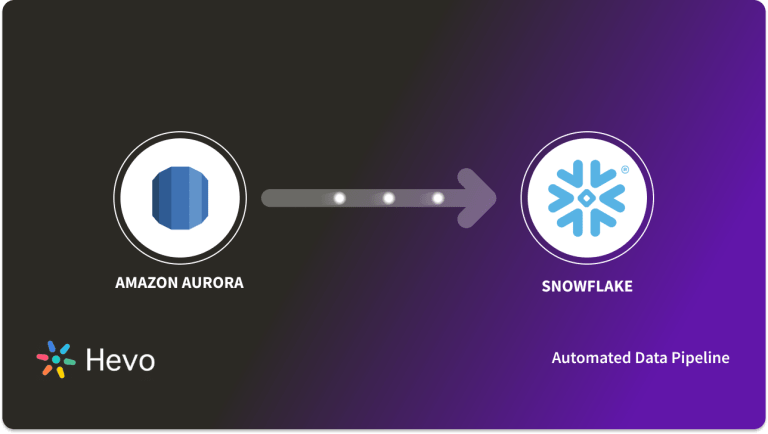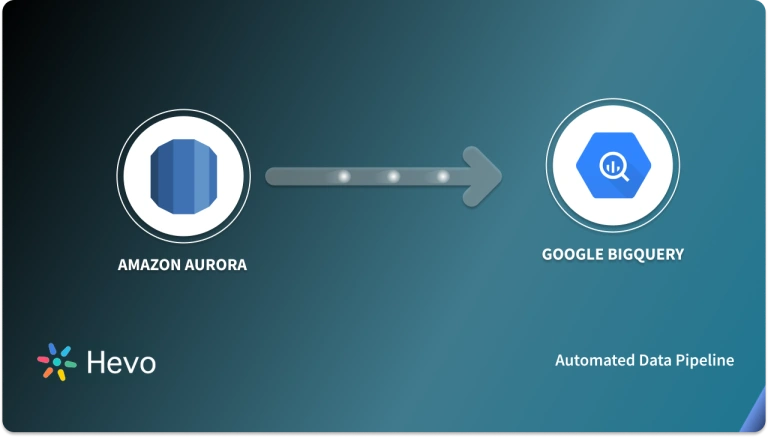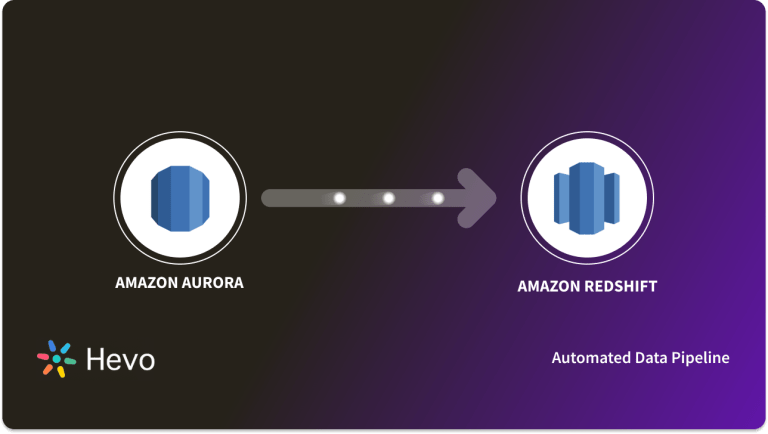AWS Data Pipeline is a data movement and data processing service provided by Amazon. Using Data Pipeline you can perform data movement and processing as per your requirement. Data pipeline also supports scheduling of Pipeline processing. You can also perform data movement residing on on-prem.
Data Pipeline provides you various options to customize your resources, activities, scripts, failure handling, etc. In the Pipeline you just need to define the sequence of data sources, destinations along data processing activities depending on your business logic and the data pipeline will take care of data processing activities.
Similarly, you can perform Aurora to Redshift Replication using AWS Data Pipeline. This article introduces you to Aurora and Amazon Redshift. It also provides you the steps to perform Aurora to Redshift Replication using AWS Data Pipeline.
Easily integrate your Aurora data with Redshift using Hevo’s no-code platform. Automate your data pipeline for real-time data flow and seamless analysis.
- Quick Integration: Connect Aurora to Redshift with just a few clicks.
- Real-Time Sync: Ensure up-to-date data with continuous real-time updates.
- No-Code Transformations: Apply data transformations without writing any code.
- Reliable Data Transfer: Enjoy fault-tolerant data transfer with zero data loss.
Simplify your Aurora to Redshift data workflows and focus on deriving insights faster with Hevo.
Get Started with Hevo for FreeTable of Contents
Method 1: Using an Automated Data Pipeline Platform
You can easily move your data from Aurora to Redshift using Hevo’s automated data pipeline platform.
Step 1: Configure Aurora as a Source
Step 2: Configure Redshift as a destination
Hevo is the only real-time ELT No-code Data Pipeline platform that cost-effectively automates data pipelines that are flexible to your needs. With integration with 150+ Data Sources such as PostgreSQL, MySQL, and MS SQL Server, we help you not only export data from sources & load data to the destinations but also transform & enrich your data, & make it analysis-ready. The unique combination of features differentiates Hevo from its competitors, including Fivetran.
Method 2: Steps to Perform Aurora to Redshift Replication Using AWS Data Pipeline
This is a method that demands technical proficiency and experience in working with Aurora and Redshift. This is a Manual Integration using AWS Data Pipeline.
Follow the steps below to perform Aurora to Redshift Replication using AWS Data Pipeline:
- Step 1: Select the Data from Aurora
- Step 2: Create an AWS Data Pipeline to Perform Aurora to Redshift Replication
- Step 3: Activate the Data Pipeline to Perform Aurora to Redshift Replication
- Step 4: Check the Data in Redshift
Step 1: Select the Data from Aurora
Select the data that you want for Aurora to Redshift Replication as shown in the image below.
Step 2: Create an AWS Data Pipeline to Perform Aurora to Redshift Replication
For MySQL/Aurora MySQL to Redshift, AWS Data Pipeline provides an inbuilt template to build the Data Pipeline. You will reuse the template and provide the details as shown in the image below.
Note: Check all the pre and post conditions in the Data Pipeline before activating the Pipeline for performing Aurora to Redshift Replication.
Step 3: Activate the Data Pipeline to Perform Aurora to Redshift Replication
Data Pipeline internally generates the following activities automatically:
- RDS to S3 Copy Activity (to stage data from Amazon Aurora)
- Redshift Table Create Activity (create Redshift Table if not present)
- Move data from S3 to Redshift
- Perform the cleanup from S3 (Staging)
Step 4: Check the Data in Redshift
Pros of Performing Aurora to Redshift Replication Using AWS Data Pipeline
- AWS Data Pipeline is quite flexible as it provides a lot of built-in options for data handling.
- You can control the instance and cluster types while managing the Data Pipeline hence you have complete control.
- Data pipeline has already provided inbuilt templates in AWS Console which can be reused for similar pipeline operations.
- Depending upon your business logic, condition check and job logic are user-friendly.
- While triggering the EMR cluster you can leverage other engines other than Apache Spark i.e. Pig, Hive, etc.
Cons of Performing Aurora to Redshift Replication Using AWS Data Pipeline
- The biggest disadvantage with the approach is that it is not serverless and the pipeline internally triggers other instance/clusters which runs behind the scene. In case, they are not handled properly, it may not be cost-effective.
- Another disadvantage with this approach is similar to the case of copying Aurora to Redshift using Glue, data pipeline is available in limited regions. For the list of supported regions, refer AWS website.
- Job handling for complex pipelines sometimes may become very tricky in handling unless. This still requires proper development/pipeline preparation skills.
- AWS Data Pipeline sometimes gives non-meaningful exception errors, which makes it difficult for a developer to troubleshoot. Requires a lot of improvement on this front.
Learn More About:
Conclusion
The article introduced you to Amazon Aurora and Amazon Redshift. It provided you a step-by-step guide to replicate data from Aurora to Redshift using AWS Data Pipeline. Furthermore, it also provided you the pros and cons to go with AWS Data Pipeline.
Amazon Aurora to Redshift Replication using AWS Data Pipeline is convenient during the cases where you want to have full control over your resources and environment. It is a good service for the people who are competent at implementing ETL solution logic. However, in our opinion, this service has not been effective and not that much success as compared to other data movement services.
This service has been launched quite a long back and is still available in a few regions. However, having said that since AWS data pipeline support multi-region data movement, you can Select Pipeline in the nearest region and perform the data movement operation using resources of the region for you movement (be careful about security and compliance).
With the complexity involves in Manual Integration, businesses are leaning more towards Automated and Continous Integration. This is not only hassle-free but also easy to operate and does not require any technical proficiency. In such a case, Hevo Data is the right choice for you! It will help simplify the Marketing Analysis. Hevo Data supports platforms like Aurora, etc.
While you rest, Hevo will take responsibility for fetching the data and moving it to your destination warehouse. Unlike AWS Data pipeline, Hevo provides you with an error-free, completely controlled setup to transfer data in minutes.
Want to take Hevo for a spin? Try Hevo’s for a 14-day free trial and experience the feature-rich Hevo suite first hand.
Share your experience of setting up Aurora to Redshift Integration in the comments section below!
FAQs
1. How many copies of your data does Amazon Aurora automatically replicate across multiple availability zones?
Amazon Aurora automatically replicates six copies of your data across three availability zones to ensure high availability and durability.
2. What is the difference between RDS replica and Aurora replica?
RDS replicas are independent read-only instances that share data with the primary instance through asynchronous replication, while Aurora replicas are tightly integrated with the primary cluster, using shared storage and providing faster failover and automated scaling.
3. What is the most efficient and fastest way to load data into Redshift?
The COPY command is the most efficient and fastest way to load data into Redshift, especially when used with data stored in Amazon S3; it allows for parallel data loading from multiple files to maximize throughput.







